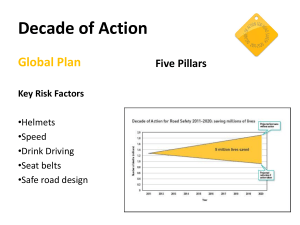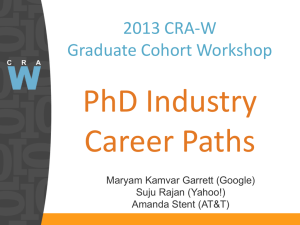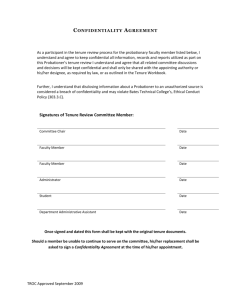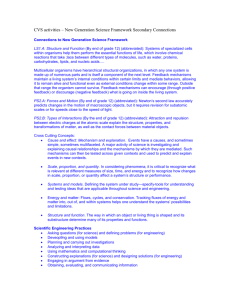Chapter 11, "Women in Academia"
advertisement
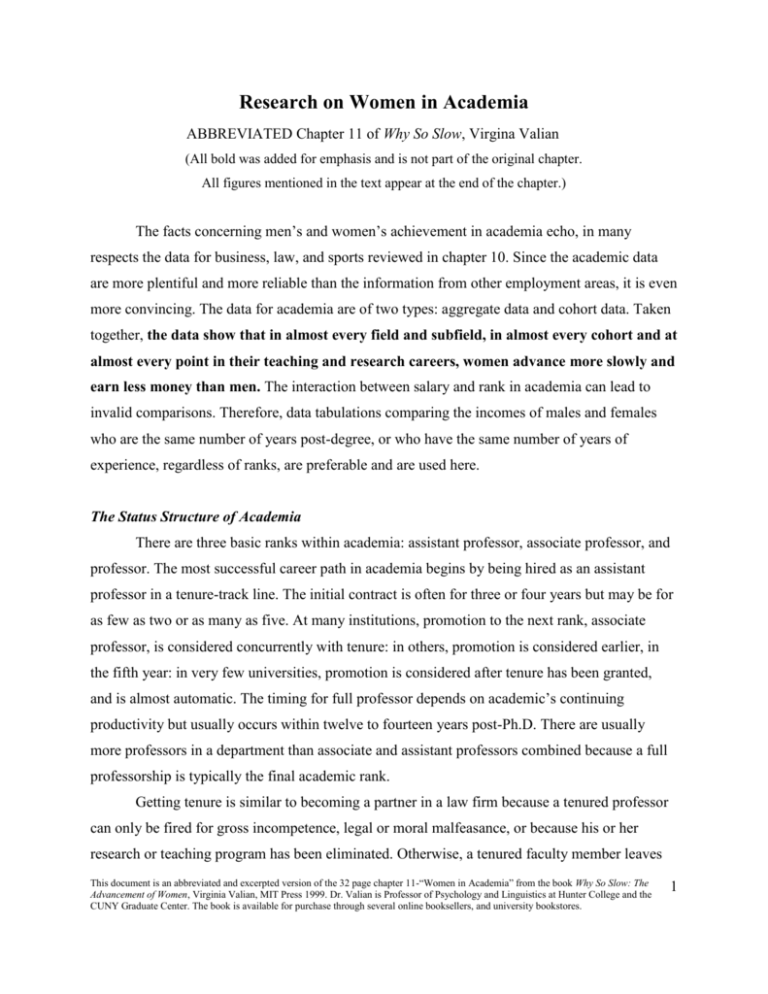
Research on Women in Academia ABBREVIATED Chapter 11 of Why So Slow, Virgina Valian (All bold was added for emphasis and is not part of the original chapter. All figures mentioned in the text appear at the end of the chapter.) The facts concerning men’s and women’s achievement in academia echo, in many respects the data for business, law, and sports reviewed in chapter 10. Since the academic data are more plentiful and more reliable than the information from other employment areas, it is even more convincing. The data for academia are of two types: aggregate data and cohort data. Taken together, the data show that in almost every field and subfield, in almost every cohort and at almost every point in their teaching and research careers, women advance more slowly and earn less money than men. The interaction between salary and rank in academia can lead to invalid comparisons. Therefore, data tabulations comparing the incomes of males and females who are the same number of years post-degree, or who have the same number of years of experience, regardless of ranks, are preferable and are used here. The Status Structure of Academia There are three basic ranks within academia: assistant professor, associate professor, and professor. The most successful career path in academia begins by being hired as an assistant professor in a tenure-track line. The initial contract is often for three or four years but may be for as few as two or as many as five. At many institutions, promotion to the next rank, associate professor, is considered concurrently with tenure: in others, promotion is considered earlier, in the fifth year: in very few universities, promotion is considered after tenure has been granted, and is almost automatic. The timing for full professor depends on academic’s continuing productivity but usually occurs within twelve to fourteen years post-Ph.D. There are usually more professors in a department than associate and assistant professors combined because a full professorship is typically the final academic rank. Getting tenure is similar to becoming a partner in a law firm because a tenured professor can only be fired for gross incompetence, legal or moral malfeasance, or because his or her research or teaching program has been eliminated. Otherwise, a tenured faculty member leaves This document is an abbreviated and excerpted version of the 32 page chapter 11-“Women in Academia” from the book Why So Slow: The Advancement of Women, Virginia Valian, MIT Press 1999. Dr. Valian is Professor of Psychology and Linguistics at Hunter College and the CUNY Graduate Center. The book is available for purchase through several online booksellers, and university bookstores. 1 an institution only by resignation, by retirement, or by death. Hence the tenure decision is the most important decision an institution makes about a faculty member. The requirements for tenure vary somewhat. Prestigious universities – institutions that award Ph.D.s and professional degrees in addition to bachelor’s degrees – demand that the candidate make significant contributions to knowledge in her or his field. Scholarly contributions are measured by both the quantity and quality of peer-reviewed publications and presentations, by success in obtaining research grants, and by other evidence that the professor is an active scholar. People still working on their Ph.D.s may be hired as instructor or lecturer. Such positions are usually not tenure-track and are one-year appointments renewed at the institution’s discretion. The positions discussed thus far are full-time positions. Academia also has part-time positions, which are generally designated as adjuncts, for example, adjunct assistant professor or adjunct lecturer. An adjunct is usually paid by course – very poorly paid, usually between $1500 and $3000. Institutions have no stake in adjuncts and seldom provide them with more than a desk or part-time office in which to meet students. A person with a Ph.D. who has a non-tenure track position is at a professional dead end. Nonetheless, one member of a couple may accept such an appointment when his or her partner is offered an attractive position, in hopes that a better job will open up at the same or nearby institution. The range of status within academia can be seen by comparing the salary and teaching load of a full-time scholar at a prestigious university with those of an adjunct. A beginning-level assistant professor at a highly regarded institution will teach two courses per semester and earn about $35,000 to $45,000 per year. In contrast, an adjunct assistant professor typically earns $1500 to $2500 per course; he or she makes far less money for far more teaching and has little time and few facilities to conduct research. Since research productivity is the key to advancement in academia, an adjunct has virtually no chance of advancing. For a successful career path, an individual may also move to a new college or university as a result of receiving better offer elsewhere, not being reappointed, being denied tenure at the original institution, or for personal reasons. There are important differences in the career paths of male and female academics. The data show that women are considerably less successful in academia than men are. This document is an abbreviated and excerpted version of the 32 page chapter 11-“Women in Academia” from the book Why So Slow: The Advancement of Women, Virginia Valian, MIT Press 1999. Dr. Valian is Professor of Psychology and Linguistics at Hunter College and the CUNY Graduate Center. The book is available for purchase through several online booksellers, and university bookstores. 2 Women earn less money, are promoted and granted tenure more slowly, and work at less prestigious institutions. Salary Across Disciplines Regardless of their discipline, women at universities and colleges at each rank have lower average salaries than men do. Moreover, the inequalities are progressive: the disparity at the assistant professor level is smaller than it is at the full professor level. The American Association of University Professors (AAUP) data in figure 1.1 compares 1996-1997 salaries for all ranks in terms of the percentage of men’s salaries that women earn at universities and colleges nationwide. Figure 1.2 (a, b, and c) shows salary data for each rank at four selected samples of elite institutions (AAUP 1997). Here, the author has included selected samples as well as the overall data to determine whether the same pattern is apparent in elite institutions as well as in institutions as whole. It might be hypothesized that elite institutions would lead the way in equitable treatment of women and other institutions would follow. The first sample of elite institutions is made up of five northeastern private universities: Harvard, Yale, Princeton, MIT, and Columbia. The second is a group of five public universities: Michigan, Wisconsin, California-Berkeley, California-Los Angeles, and Texas. The five small northeastern coeducational colleges in the third sample are Swarthmore, Amherst, Williams, Wesleyan, and Haverford. The final sample is made up of five small northeastern women’s colleges: Wellesley, Smith, Mt. Holyoke, Bryn Mawr, and Barnard. The figures allow us to test the hypothesis about elite institutions by comparing the averages for the two university samples with the averages at universities nationwide (AAUP’s Category I). The averages for the two college samples can also be compared with those for all undergraduate colleges without significant numbers of higher-degree programs (AAUP’s Category IIB). Figure 11.1 shows that average salaries for women at each rank are lower than men’s. At universities, women average 91% of men’s full professor salaries and 93% of their assistant professor salaries. At the colleges, the comparable figures are 94% and 98%. Comparison of the two university samples in figure 11.2 (a, b, and c) suggests that elite private universities pay men and women slightly better at these two ranks ( 91% and 95%) than This document is an abbreviated and excerpted version of the 32 page chapter 11-“Women in Academia” from the book Why So Slow: The Advancement of Women, Virginia Valian, MIT Press 1999. Dr. Valian is Professor of Psychology and Linguistics at Hunter College and the CUNY Graduate Center. The book is available for purchase through several online booksellers, and university bookstores. 3 elite public universities do (82% and 92%). The averages for the two college samples in figure 1.2 (a, b, and c) show that women’s schools pay men and women roughly equally at both ranks (97% and 100%), in contrast to private coeducational schools, which pay assistant professors equally (97%) but women full professors only 88% of men’s salaries. Since women hold lower positions longer than men do, the salary figures at the ranks of assistant and associate levels are misleadingly positive and underrepresent the gender disparity. Some of the discrepancy in current salary figures may be due to the fact that there are fewer women in more highly paid disciplines (such as computer science). However, even when the data are reported by discipline, they show that women earn less than men in almost every field. Humanities The 1995 figures compiled by the National Research Council (NRC) for a sample of men and women Ph.D.s in humanities are subdivided by number of years post-Ph.D., allowing to compare male and female Ph.D.s at the same level. Such information maximizes the likelihood of comparing individuals with the same training and background at the same point in their careers. The data shows that the median salaries of full-time male and female humanities who were zero to five years post-Ph.D. were equal, at approximately $34,000. At all further intervals post-Ph.D., however, women’s salaries lagged behind men’s: they averaged 95% of men’s at 615 years post-Ph.D., 96% at 16-25 years and 89% at over 25 years. Overall, women humanists earned 84% of men’s salaries. The data is thus encouraging suggesting that women and men start out on an equal salary footing. But at the same time, they are discouraging indicating that the later salary inequalities found in earlier surveys are continuing. Science and Engineering 1993 salary data for samples of scientists and engineers with Ph.D.s from mathematics, computer specialties, psychology, and social science (such as economics and sociology), as well as physics, chemistry, biology, and traditional engineering fields show that the average income of women from all fields combined was 78% of the men’s average. Even within individual field, women earned less than men. Same was the case amongst the newest Ph.D.s with women faring This document is an abbreviated and excerpted version of the 32 page chapter 11-“Women in Academia” from the book Why So Slow: The Advancement of Women, Virginia Valian, MIT Press 1999. Dr. Valian is Professor of Psychology and Linguistics at Hunter College and the CUNY Graduate Center. The book is available for purchase through several online booksellers, and university bookstores. 4 worse than men. In 1993 the average female in this cohort earned 89% of the average male’s salary $37,600, compared to $41,900. There is a lack of parity for new graduates due to nonacademic employment sectors. Academia does not provide salary parity for even slightly more experienced women. In 1993, women whose degrees were awarded between 1985 and 1990 earned 92% of men’s salaries; women with degrees from 1980 to 1984 earned 90%; and those with degrees from 1970 to 1979 earned 86%. Overall, women scientists in universities and four-year colleges earned about 80% of men’s salaries. In sum, the picture for science and engineering in academia is similar to that for the humanities. The most recent female graduates start out on an equal salary footing with males but lose that equality as early as three to eight years post-Ph.D. The salary disparity increases with years post degree. The salary discrepancies between men and women in science and engineering are greater than they are in humanities. Rank and Tenure Salary is only one aspect of status in academia; rank and tenure, are, if anything, more important measures of status in academia. Women in all fields are overrepresented in lowstaus and untenured positions according to data available for humanists, scientists and engineers, and for academics in general. This discussion of academia presents both rank and gender percentages, as they tell us different things about women’s and men’s career patterns. Rank Percentages For each rank or status level, rank percentages reflect the numbers of female and male occupants at that rank. These rank percentages only tell us how far we are from equality within each rank but does not tell us the source of the inequality. The numbers of each sex that make up the candidate pool constrains the rank percentages. Thus, we must take into account the size of the pool while also acknowledging that the composition of the pool could itself reflect prior inequalities in trying to determine what the percentage of women “should” be in any rank or status. Gender Percentages This document is an abbreviated and excerpted version of the 32 page chapter 11-“Women in Academia” from the book Why So Slow: The Advancement of Women, Virginia Valian, MIT Press 1999. Dr. Valian is Professor of Psychology and Linguistics at Hunter College and the CUNY Graduate Center. The book is available for purchase through several online booksellers, and university bookstores. 5 Gender percentages express separately for women and men what percentage of each group occupies a particular rank. Gender percentages are useful for tracking the careers of people who received their degrees at about the same time and are therefore in the same cohort. These figures are independent of the size of the pool. For example, we can take males and females in the 1980 cohort (those who received their degrees in 1980) and ask what percentage of the males and females were full professors in 1990. We would expect that, in the absence of other differences, males and females from the same cohort would have the same profiles ten years later. Gender percentages also provide another measure of equality. But gender percentages are less useful for comparing groups that are not in the same cohort, because the groups may vary on dimensions other than gender Rank Across Disciplines Women are a minority in every rank. They are only 13% of full professors at universities and 21% at colleges. The long-standing and continuing commitment of women’s colleges to hire and promote women is visible in figure 1.3 (a, b, and c). As mentioned earlier knowing the composition of the candidate pool is very important in order to determine the gender imbalances in hiring and promotion. However, the pool is difficult to establish because both the number of Ph.D.s awarded and the gender composition of the recipients is constantly changing every year. The number of women Ph.D.s has increased tremendously in past few decades. Also the percentage of women receiving Ph.D.s has been and continues to be white with as little as 9% of the doctorates awarded to black and Hispanic women. The women’s movement of the early 1970’s appears to have been a galvanizing force behind white women’s entry into fields dominated by men thus paralleling the influx of white women into higher education that began in the 1970’s by an influx of white women into law schools, medical schools, business schools, and sports. Tenure Across Disciplines In 1996-1997 the gender percentages show that 96% of men at universities nationwide were in tenured or tenure-track appointments, compared to 85% of women. At This document is an abbreviated and excerpted version of the 32 page chapter 11-“Women in Academia” from the book Why So Slow: The Advancement of Women, Virginia Valian, MIT Press 1999. Dr. Valian is Professor of Psychology and Linguistics at Hunter College and the CUNY Graduate Center. The book is available for purchase through several online booksellers, and university bookstores. 6 colleges that primarily award bachelor’s degrees, the figures are 94% for men and 88% for women. These percentages for both types of institutions show that men are more likely to be tenured than women are, but as the data are not recognized by cohort, the reasons for the imbalance are not clear. At both universities and colleges, women appear to be underrepresented in tenured or tenure-track positions and overrepresented in non tenure positions. Because such aggregate figures could be skewed by the large percentage of older male full professors, these were excluded and new values computed. The distributions of remaining full-time men and women in the other ranks were compared. The asymmetry still remained. At the universities 39% of the women and 57% of the men were associate professors; 43% of the women and 34% of the men were assistant professors; and 19% of the women and 9% of the men were instructors or lecturers or held no ranks. The figures for the undergraduate colleges were comparable. When full professors were excluded, 36% of the women and 48% of the men were associate professors; 50% of the women and 43% of the men were assistant professors; and 16% of the women and 9% of the men were instructors or lecturers or held no rank. Women continue to be overrepresented at the bottom ranks. Moreover, across all fields, ages, and institutions, figures for 1995-1996 showed that 72% of academic men were tenured, compared to only 48% of women. To sum up, the rank and tenure data across all disciplines demonstrate the women in academia fare considerably worse than men. The Humanities To evaluate whether academic women’s opportunities to attain rank and tenure were affected by the disciplines they specialized in, the data for the two broad areas of humanities and sciences was considered. In 1995, 35% of the employed Ph.D.s in the humanities were women. According to the NRC (1997), in 1995, women in the humanities who were 0-5 years post-Ph.D. fared less well in rank than men, despite their overall equality of salary. That statistic suggests that the salary data are misleading. Women advance through the ranks more slowly than men, leaving more older women than older men in the lower ranks. That imbalance makes the salary figures appear more comparable than they actually are. This document is an abbreviated and excerpted version of the 32 page chapter 11-“Women in Academia” from the book Why So Slow: The Advancement of Women, Virginia Valian, MIT Press 1999. Dr. Valian is Professor of Psychology and Linguistics at Hunter College and the CUNY Graduate Center. The book is available for purchase through several online booksellers, and university bookstores. 7 The gender percentages show that 3.1% of employed new male Ph.D.s compared to 2.2% of females became full professors within six years. To become a full professor in such a short period of time is a major achievement in academia. This data suggests that men are slightly more likely than women to be perceived as stars, something to be expected on gender schemas. More telling are the data for the lowest ranks – instructor, lecturer, adjunct, and positions that carry no rank which lead us to expect that women carry an implicit minus sign that keeps many of them at the bottom or out of work. The figures for humanities are particularly important, because they demonstrate that even the newest Ph.D.s have differential success rates. One to six years post-Ph.D., women were as likely as men to be in similar positions. In 1995 new women Ph.D.s were 82% as likely as men to achieve associate or full professor status within six years, but 114% as likely as men to end up in the least advantageous positions and 259% as likely to be involuntarily unemployed. Six to fifteen years post-Ph.D., the situation is considerably worse with only 10% of women as full professors, compared to about 21% of men. Approximately equal percentages of men and women were associate professors, and more women (21%) than men (14%) were still at the assistant professor level. In the bottom ranks were 17% of men and 24% of women. Thus the tenure equality between men and women disappears by six to fifteen years post-Ph.D. and a smaller percentage of women have tenure as compared to men, in humanities. Science and Engineering In 1993, women ranged from 4% of faculty in engineering departments to 30% of faculty in social science and related fields. Gender percentages for 1993 show that 61% of the men in science and engineering were tenured, compared to 35% of women. It was assumed that the imbalance was due to the age difference. Even if the difference in age distribution fully accounted for the disparity, the combined tenure plus tenure-track percentages were not equal for men and women. Overall, only 60% of women were in tenured or tenure-track positions, compared to 77% of men. And, like women in the humanities, women in science were disproportionately represented in non-tenure track positions. New women Ph.D.s in science fields fared better in tenure-track status than older women Ph.D.s, but even new women lagged behind new men. The plight of women who earned degrees This document is an abbreviated and excerpted version of the 32 page chapter 11-“Women in Academia” from the book Why So Slow: The Advancement of Women, Virginia Valian, MIT Press 1999. Dr. Valian is Professor of Psychology and Linguistics at Hunter College and the CUNY Graduate Center. The book is available for purchase through several online booksellers, and university bookstores. 8 before 1985 is seen most sharply at the levels of full professor and assistant professor. In 1993, 14% of women compared to 6% of men were still assistant professors. Only 31% of the women, but 59% of the men, were full professors that year. Thus women scientists are moving through the ranks in academia at a slower rate than men. A different sample of men and women scientists, intended to represent those who show high level of achievement early in their career, was studied from 1987 to 1990 in which the participants had received postdoctoral fellowships from either the National Science Foundation or the National Research Council between 1952 and 1986. Since these national fellowships are prestigious, the men and women who earn them are roughly equal in terms of human capital and performance at the start of their academic careers. Nonetheless, with the exception of biologists, women with such fellowships were less successful at moving through the ranks than men were. The women in this sample were somewhat less productive than the men; but even when productivity was taken into consideration, the women (except biologists) held lower ranks than comparable men. Thus, even women who have obtained a prestigious credential profit from it less than men do. Women also did less well than men in terms of the relation between their ranks and the prestige of their institution. For women, the more prestigious their institution the lower their rank, whereas for men, there was no relation. Finally, the time men and women spent earning a degree to their relationship with their dissertation director were assessed. It was observed that although men and women were equally likely to have an influential advisor that helped men more than women. Productivity also helped men more than it helped women. The study of postdoctoral fellowships awarded by Swedish Medical Research Council in 1995 showed that men had five times the edge over women. Prestige of Institution and Teaching Load Women professors are underrepresented on the faculties of high-prestige institutions and overrepresented at low-prestige schools. If broadly universities are defined as higher-prestige institutions and colleges as lower-prestige institutions, there is an evidence of women’s lower prestige in 1996-1997 AAUP figures, when women were 27% of university faculty but 38% of college faculty. As noted earlier, faculty at many colleges teach more course This document is an abbreviated and excerpted version of the 32 page chapter 11-“Women in Academia” from the book Why So Slow: The Advancement of Women, Virginia Valian, MIT Press 1999. Dr. Valian is Professor of Psychology and Linguistics at Hunter College and the CUNY Graduate Center. The book is available for purchase through several online booksellers, and university bookstores. 9 than their peers at universities. Partly as a consequence of women’s greater representation in colleges, then, women teach more than men, even taking into account rank, discipline, and Ph.D. cohort. Progress in Academia The results for progress in academia on the basis of salary, rank, and tenure have been mixed. With respect to salary, it was seen that the very youngest male and female professors in the humanities were on a par in 1993, which represents clear progress compared to the 1980’s. But for those more than five years post-PhD., women’s salaries continue to lag behind men’s. For scientists and engineers there has been less progress: younger and older women alike are paid far less than their male peers. Overall salary data for universities and colleges show almost no progress between 1980 and 1996 as illustrated in figures 11.5 and 11.6. In some samples there has even been regression. Some of the reverse progress could be explained if the largest increases in new appointment occurred in disciplines that pay less. For example, English faculty earns less than computer science faculty: $46,000 for English professors in 1995 but $60,800 for computer scientists. There are larger percentages of women in literature than in computer science. In 1993, 57% of Ph.D.s in English and American Literature were earned by women, compared to 15% of doctorates in computer and information science. Thus if most new female appointments were in lower-paying disciplines, women’s salaries would be, on an average lower than men’s. Although this asymmetry might contribute to the regression but there is also a considerable gender inequality even among young scientists and engineers. Women’s progress in occupying more positions is clear. The percentages of women at all tenure-track ranks at both universities and colleges were greater in 1996-1997 than in 1980-1981 as seen in figures 11.6 and 11.7. At the same time, however, there were more women in marginal positions than ever before. Compared to men, women are still much more likely to hold marginal jobs or to be involuntarily unemployed. In sum, women remain overrepresented at the bottom and at the margins and underrepresented at the top, though less extremely so than in the past. This document is an abbreviated and excerpted version of the 32 page chapter 11-“Women in Academia” from the book Why So Slow: The Advancement of Women, Virginia Valian, MIT Press 1999. Dr. Valian is Professor of Psychology and Linguistics at Hunter College and the CUNY Graduate Center. The book is available for purchase through several online booksellers, and university bookstores. 10 Finally, since 1976 there has been a zero progress in closing the tenure gap between men and women. Although the percentage of women who are tenured increased from 44% in 1976 to 50% in 1994, the tenure rates of men also increased, from 64% to 71%. Figure 11.8 shows those figures for all institutions nationwide, and figure 11.9 illustrates the tenure disparities in universities and colleges separately. Since 1980 there has been a consistent gender gap of 28 percentage points at universities and 22 percentage point at four-year colleges (National Center for Education Statistics 1992, 1996). The data for institutions that grant tenure also show that there has been no progress in reducing tenure disparity. In 1995-1996, 48% of women and 72% of men were tenured (AAUP 1996) while the comparable AAUP figures for 1976-1977 were 44% for women and 64% for men. At private universities in 1995-1996 only 47% of women, compared to 71% of men, had tenure; at public universities the proportions are 50% and 74% (AAUP 1996). The tenure situation is probably even worse than it appears, because women are unlikely to be moving through the ranks as fast as men are. With the available data, it is difficult to determine the number of women who should be tenured. But the best estimate is that a considerably higher percentage of women should be tenured than are at present. The lack of progress in tenure does not seem attributable to the ever-increasing percentage of women assistant professors, a rank that rarely carries tenure. Overall, progress in the standing of academic women is mixed. Salary equality has come to only the newest members of academia and is most visible in humanities. In sheer numbers, progress has been clear with more women in the total academic population than ever. Yet women are still markedly underrepresented at the top and grossly overrepresented at the bottom and among the involuntarily unemployed. Women are also still disproportionately untenured, and the disparity vis-à-vis men has not changed since early 1980’s. Most academics probably have the impression of more progress than the facts indicate. One likely reason for that perception is that more women than ever are walking the halls of academe. Since there were such small percentages of tenure-track women at most campuses in earlier years, even small increases are very noticeable. Other reasons suggest themselves as well. Some institutions – notably, women’s colleges, and, to a lesser extent, coeducational colleges – are doing better than others. This document is an abbreviated and excerpted version of the 32 page chapter 11-“Women in Academia” from the book Why So Slow: The Advancement of Women, Virginia Valian, MIT Press 1999. Dr. Valian is Professor of Psychology and Linguistics at Hunter College and the CUNY Graduate Center. The book is available for purchase through several online booksellers, and university bookstores. 11 Women may also be more active professionally and hence more noticeable than before. Women may be serving on committees in disproportionate numbers. The institutionalization and development of women’s studies program may be making women more visible. Still, the data indicate that perceptions of progress in academia are rosier than the facts support. It is clear that parity will not be achieved without special effort. Summary The data demonstrate that women in academia are substantially under rewarded. They are paid less, promoted more slowly, and tenured more slowly. Except for the number of women in assistant and associate professor positions, progress from 1980 to 1996 was slow and slight in every area. Nor can women’s slower advancement be accounted for by a lower standard or performance. Even when productivity is controlled for, women earn less and achieve tenure more slowly than men do. And, as chapter 12 shows, although women publish less than me, what they publish is of higher quality – as measured by the number of times their work is cited by other scholars in their field. This document is an abbreviated and excerpted version of the 32 page chapter 11-“Women in Academia” from the book Why So Slow: The Advancement of Women, Virginia Valian, MIT Press 1999. Dr. Valian is Professor of Psychology and Linguistics at Hunter College and the CUNY Graduate Center. The book is available for purchase through several online booksellers, and university bookstores. 12 This document is an abbreviated and excerpted version of the 32 page chapter 11-“Women in Academia” from the book Why So Slow: The Advancement of Women, Virginia Valian, MIT Press 1999. Dr. Valian is Professor of Psychology and Linguistics at Hunter College and the CUNY Graduate Center. The book is available for purchase through several online booksellers, and university bookstores. 13 This document is an abbreviated and excerpted version of the 32 page chapter 11-“Women in Academia” from the book Why So Slow: The Advancement of Women, Virginia Valian, MIT Press 1999. Dr. Valian is Professor of Psychology and Linguistics at Hunter College and the CUNY Graduate Center. The book is available for purchase through several online booksellers, and university bookstores. 14 This document is an abbreviated and excerpted version of the 32 page chapter 11-“Women in Academia” from the book Why So Slow: The Advancement of Women, Virginia Valian, MIT Press 1999. Dr. Valian is Professor of Psychology and Linguistics at Hunter College and the CUNY Graduate Center. The book is available for purchase through several online booksellers, and university bookstores. 15 This document is an abbreviated and excerpted version of the 32 page chapter 11-“Women in Academia” from the book Why So Slow: The Advancement of Women, Virginia Valian, MIT Press 1999. Dr. Valian is Professor of Psychology and Linguistics at Hunter College and the CUNY Graduate Center. The book is available for purchase through several online booksellers, and university bookstores. 16 This document is an abbreviated and excerpted version of the 32 page chapter 11-“Women in Academia” from the book Why So Slow: The Advancement of Women, Virginia Valian, MIT Press 1999. Dr. Valian is Professor of Psychology and Linguistics at Hunter College and the CUNY Graduate Center. The book is available for purchase through several online booksellers, and university bookstores. 17 This document is an abbreviated and excerpted version of the 32 page chapter 11-“Women in Academia” from the book Why So Slow: The Advancement of Women, Virginia Valian, MIT Press 1999. Dr. Valian is Professor of Psychology and Linguistics at Hunter College and the CUNY Graduate Center. The book is available for purchase through several online booksellers, and university bookstores. 18 This document is an abbreviated and excerpted version of the 32 page chapter 11-“Women in Academia” from the book Why So Slow: The Advancement of Women, Virginia Valian, MIT Press 1999. Dr. Valian is Professor of Psychology and Linguistics at Hunter College and the CUNY Graduate Center. The book is available for purchase through several online booksellers, and university bookstores. 19 This document is an abbreviated and excerpted version of the 32 page chapter 11-“Women in Academia” from the book Why So Slow: The Advancement of Women, Virginia Valian, MIT Press 1999. Dr. Valian is Professor of Psychology and Linguistics at Hunter College and the CUNY Graduate Center. The book is available for purchase through several online booksellers, and university bookstores. 20 This document is an abbreviated and excerpted version of the 32 page chapter 11-“Women in Academia” from the book Why So Slow: The Advancement of Women, Virginia Valian, MIT Press 1999. Dr. Valian is Professor of Psychology and Linguistics at Hunter College and the CUNY Graduate Center. The book is available for purchase through several online booksellers, and university bookstores. 21 This document is an abbreviated and excerpted version of the 32 page chapter 11-“Women in Academia” from the book Why So Slow: The Advancement of Women, Virginia Valian, MIT Press 1999. Dr. Valian is Professor of Psychology and Linguistics at Hunter College and the CUNY Graduate Center. The book is available for purchase through several online booksellers, and university bookstores. 22 This document is an abbreviated and excerpted version of the 32 page chapter 11-“Women in Academia” from the book Why So Slow: The Advancement of Women, Virginia Valian, MIT Press 1999. Dr. Valian is Professor of Psychology and Linguistics at Hunter College and the CUNY Graduate Center. The book is available for purchase through several online booksellers, and university bookstores. 23


